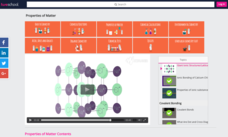Curated Video
Describing Data Sets
In this video, students will learn how to describe a data set by using the characteristics of the quantity measured. The video covers different types of data representations such as dot plots, histograms, and tables, and explains how to...
Science360
Hydraulic fracturing Using scientific methods to evaluate trade-offs
In Colorado, drilling for oil and natural gas using hydraulic fracturing, sometimes referred to as fracking, is big business. But questions about its impact on the air and water are far from settled. With support from the National...
Rock 'N Learn
What is Multiplication?
Here is the fun and easy way to learn to read with Rock 'N Learn Mathematics. Enjoy learning with fun, catchy, engaging mathematics songs.
Curated Video
Multiplying by a Fraction Less than One
In this video, students learn how multiplying by a fraction less than one affects the product using visual models. The video explains important concepts such as factors, product, and the value of fractions with a numerator less than the...
Curated Video
How Do Atoms Bond | Properties of Matter | Chemistry | FuseSchool
How Do Atoms Bond | Properties of Matter | Chemistry | FuseSchool NOTE: animation error at 2:40 - the periodic table is supposed to be twisted clockwise, and not like it is shown in the video. The twisting enables the element Cs to...
Curated Video
How Do Atoms Bond - Part 2 | Properties of Matter | Chemistry | FuseSchool
Learn the basics about how atoms bond when learning about the structure of atoms. Bonds form by the attraction of negatively charged electrons and the positive nucleus of atoms. Atoms have a positively charged tiny nucleus which contains...
Teacher's Pet
Ionic Bond and Ionic Compounds
It's true! Opposites do attract! A straightforward video lesson explains the basics of ionic bonding. Using visual models, the instructor describes the repeating patterns in an ionic compound. She also explains how a formula unit simply...
Teacher's Pet
Naming and Writing Ionic Formulas
Explore the process of writing and naming ionic formulas and compounds. Pupils learn to build ionic compounds by analyzing their charges. The instructor then explains how to name the newly created compound.
Fuse School
Giant Ionic Structures/Lattices
Ionic compounds don't exist as individuals; they only exist as a small part of an ionic lattice. The fourth video in a series of six discusses how the lattices form. It explains the attraction of ions and the common properties of these...
Get Chemistry Help
Chemistry Lesson: Identifying Ionic vs. Molecular Compounds
Is that compound ionic or molecular? How can you tell? Pupils learn about naming chemical compounds and classify them as being molecular or ionic. They learn in detail as they build foundational skills in the short, yet informative,...
Fuse School
How Atoms Bond - Elements and Compounds Part 2
Build a solid foundation of the different types of chemical bonds. A thorough video lesson discusses the formation of chemical bonds between various element types. The instructor references the periodic table when discussing molecular...







